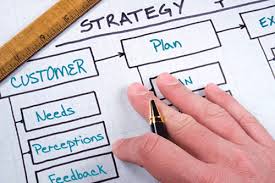 Most if not all small businesses are aware of the need to acquire a customer focus, to make the business more customer-centric, and to really get to know their customers. Businesses know they need a strategy to harvest the full crop of potential returns from their customers but how can they go about creating it?
Most if not all small businesses are aware of the need to acquire a customer focus, to make the business more customer-centric, and to really get to know their customers. Businesses know they need a strategy to harvest the full crop of potential returns from their customers but how can they go about creating it?
The interesting thing about the answer to this question is that the best source of background to use for developing a customer strategy is your base of existing customers and your team members who serve them. They’ll gladly tell you how to satisfy customers, how to generate higher returns from them, and even how to get more of them; all you have to do is to ask them the right way.
1. Talk to Customers About how They See You
Select a sample of from five to ten of your “best” customers. This will be those who have dealt with your business long enough to have formed opinions about your business, from the way it treats its customers to how accurate your monthly invoices are. You’re looking for all opinions, both good ones and bad ones.Talk one-on-one with everyone who can provide insights into how your business is seen by those who support it. Why do they buy from you? What happens when they look around for other suppliers? You want to find out what you’re doing well and what needs improving, and these are the people who can tell you what you need to know.
2. Talk to Your Customer Service Team
Review the feedback you get from customers with the people in your business that interact with them. See where perceptions match up and where your customer service team’s opinions differ from those of the customers themselves. As with the customer interviews, do this one-on-one with your team. This will ensure you get everybody’ thoughts instead of just those who are willing to speak up in a group.
3. Assimilate the Intelligence You’ve Gathered
Organize the information you’ve gathered from customers and team members into positive and negative segments. From all this material some clear lines will emerge that can become the basis of your customer strategy. You’ll see problems that need to be corrected and you’ll also see where you’re doing things right and can build additional success from there.
4. Design the Ideal Customer Relationship
What have you found that represents the ideal relationship to have with a customer? You should have enough information to know what will optimize your relationships with customers in such a way that both of you are satisfied and want to sustain the connection.
This will involve considerations of people and processes. What kinds of people serve your customers best? What processes need to be added or corrected so that customer satisfaction is created or enhanced?
5. Create the Customer Strategy Your Business Needs
Look into every aspect of your own organization that impacts on customer relationships and see what it would take to have this ideal relationship with every customer. It might be achieved through training or other staff educational programs, through the acquisition of a CRM system – probably through a combination of many actions.
Your goal is to replicate the ideal customer relationship across all customers of your business. How you do it will be the content of your strategy. Write down a plan of action that will structure your business in such a way that it has this ideal relationship with all customers. Whatever it takes, you have to do it.
6. Get Your Team On-Side
When a business undergoes a process of self-examination and has to confront every aspect of its operations, both good and bad, it can be unsettling for team members who might feel threatened by confirming that all isn’t perfect in what they’e been doing. An important part of your strategy has to be getting the team to accept the changes needed and to see the strategy’s goals as their own.
Give them opportunities to provide input into how the strategy will be implemented across the business. Don’t rush through the process of creating your “ideal” organization; move toward the goals carefully and monitor progress every step of the way. Keep team members informed so they continue to feel a part of the evolution.
7. Keep on Top of Things
Now that you’ve learned how valuable customer intelligence is, develop a plan to obtain it on a regular basis. This will be the best possible way to see if your strategy is working so that you can fine-tune it as needed.
Every time you hire a new team member be sure they will accept and work within the businesses’ customer strategy. Initiate refresher training courses that keep all team members’ customer relationship skills at a high level. A customer strategy is ongoing and needs to be maintained as carefully as any of the company’s equipment.
Copyright 2005, RAN ONE Inc. All rights reserved. Reprinted with permission from www.ranone.com

 Chris’ combination of academic credentials, career experience and temperament ideally suit his calling as a business development advisor. Clients say he has a mind for business and a heart for service.
Chris’ combination of academic credentials, career experience and temperament ideally suit his calling as a business development advisor. Clients say he has a mind for business and a heart for service.